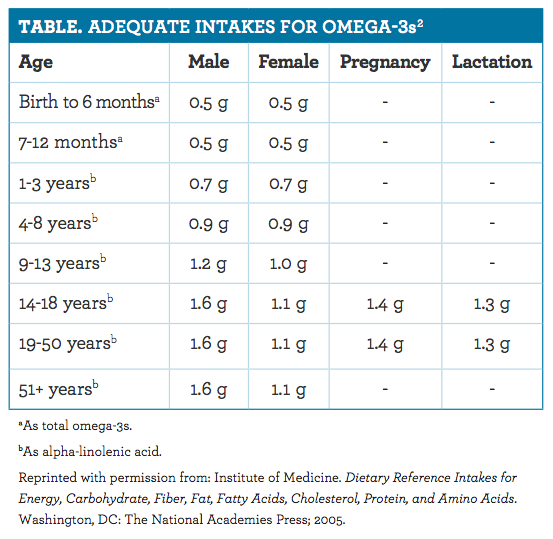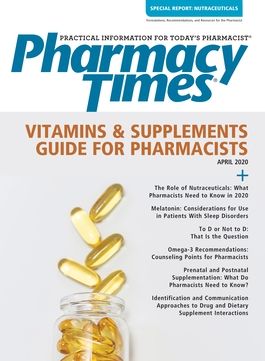Publication
Article
Supplements
Omega-3 Recommendations: Counseling Points for Pharmacists
Author(s):
As a pharmacist, it is important to know which patients may benefit from omega-3 supplements the most, the supplements’ proper dosage, and the benefits that can be expected.
Omega-3 fatty acids (omega-3s) have received much publicity and advertising attention over the last few years stating that they are an essential supplement many people should consider taking. As a pharmacist, it is important to know which patients may benefit from omega-3 supplements the most, the supplements’ proper dosage, and the benefits that can be expected. It is also important to know which health claims about omega-3s have the most validity. OMEGA-3
COMPONENTS AND SOURCES
Omega-3 fatty acids have 2 main components that are beneficial in humans: eicosapentaenoic acid (EPA) and docosahexaenoic acid (DHA). DHA levels are highest in the retina and brain. Omega-3s can also be used to form eicosanoids, which have activity in the cardiovascular, pulmonary, immune, and endocrine systems. A third component of omega-3s, alpha-linolenic acid (ALA), is not active in the body, but it can be converted to EPA and DHA.1,2
The primary vehicle for EPA and DHA to enter the body is through the consumption of fish and other seafood, so the American Heart Association recommends consuming 2 servings of fish per week, particularly fatty fish such as tuna, salmon, herring, or sardines, which have high levels of omega-3s.1,3 For patients who do not get enough omega-3s through their diet or who require a higher level than what their diet provides, OTC and prescription dietary supplements of omega-3s may help to meet their daily needs.
FISH OIL SUPPLEMENTS
Fish oil supplements are a common source of DHA and EPA. For individuals who cannot tolerate fish oil, or do not wish to take it, omega-3s are also contained in krill, cod liver, and algal oil supplements.
Fish oil supplements come in various dosage forms or combinations. A target dose of around 1 g of omega-3s is a good place to start.4 When taking fish oil supplements, patients may experience an unpleasant “fishy” taste; however, the use of higher-quality products with a United States Pharmacopeia seal may alleviate this problem, as these products may be less likely to have the unpleasant taste or smell.5 Patients may also be advised to store the capsules in the refrigerator or to take them at bedtime to avoid the unpleasant taste.
Krill oil, sourced from tiny crustaceans called krill, can be an alternative for patients who cannot tolerate the fishy smell or taste that can be associated with fish oil supplements. Krill oil is more stable than fish oil, which may mean it is absorbed better, and because it is not sourced from fish, it may be less likely to cause a fishy aftertaste. The use of krill oil has not been studied as extensively as that of fish oil, however, and probably should remain as a secondary recommendation until further research reinforces its safety and effectiveness. The recommended dosage from the manufacturer will be included on the krill oil product that is selected.6
For those patients who follow a vegetarian or vegan diet, pharmacists may recommend an algal oil supplement to add omega-3s to their diet. Algal oil is derived from algae and may be a good source of EPA and DHA; however, studies on algal oil have not been extensive.7,8 Recommendations of these products may need to be limited to only those patients who cannot tolerate fish oil or those patients who do not consume any fish products because of dietary preferences or needs. Pharmaceutical-grade omega-3 products are also available and are prescribed in dosages as high as 4 g per day. These products are indicated for patients with very high triglyceride levels.9 Patients should be advised to not take dosages in this range through OTC products without the advice of their physician.
BENEFITS OF OMEGA-3s
The efficacy of omega-3s in various conditions has been researched extensively, sometimes with conflicting results. Several trials have been conducted researching the link between a diet rich in omega-3s and a decreased risk of cardiovascular disease.9 Although these data vary across studies, the FDA states that there is supportive (but not conclusive) research indicating that consumption of EPA and DHA may reduce the risk of coronary heart disease.9
DHA is important for fetal growth and is found in high concentrations in the cellular membranes of the brain and the retina, and so many prenatal vitamins and infant formulas are fortified with DHA. Omega-3s have anti-inflammatory properties, and their use may provide some relief from mild inflammation or joint pain as well as help to reduce patients’ reliance on nonsteroidal antiinflammatory drugs for inflammation.10
Many other benefits claimed for omega-3s have been studied but have been proved inconclusive. These include potential benefits studied in patients with dementia, depression, and attention deficit/hyperactivity disorder, as well as cancer prevention.9 Continued research is needed to try to uncover additional benefits or to confirm the validity of other perceived advantages of a diet rich in omega-3s.
RECOMMENDED DOSES
According to Dietary Guidelines for Americans 2015-2020, the goal for most Americans should be to consume 8 oz of seafood per week, which is about 250 mg of EPA and DHA per day.11 For those patients who are looking for more advanced benefits from omega-3s, pharmacists may recommend a total dose of 1 g per day via supplements.4 Patients with very high levels of triglycerides can be prescribed doses as high as 4 g per day while under supervision of a physician.9
The Institute of Medicine published a guideline in 2005 for intake of total omega-3s for infants and of ALA for children and adults, which is still used by the National Institutes of Health today (see table).2

CONCLUSIONS
The use of omega-3 supplements may be beneficial for some patients; however, the most effective way to add omega-3s to the diet is by consuming them through food. Pharmacists may recommend 2 servings of fatty fish per week to patients as a starting point, which will not only introduce the beneficial EPA and DHA components into the diet but may also replace foods or meals that are not as healthy. For patients who are unwilling or unable to eat fish every week, other foods that are rich in omega-3s, such as flaxseeds, walnuts, Brussels sprouts, soybeans, or seaweed, can be recommended. Omega-3 supplements such as fish oil, krill oil, or algal oil are the next alternative for patients who cannot consume enough omega-3s from their diet. Pharmacists should be prepared to answer questions about omega-3 supplementation and know which types of patients could benefit from them the most. Educating patients on the reasoning for a recommendation and encouraging them to discuss recommendations with their physician will go a long way in ensuring positive outcomes.
BRADY COLE, RPH, is pharmacy manager at Tom Thumb Pharmacy in Plano, Texas, and an active preceptor at Texas Tech University and the University of Houston. He is also the founder of the website Helpful Pharmacist (helpfulpharmacist.com).
REFERENCES
- Harris WS. Omega-3 fatty acids. In: Coates PM, Betz JM, Blackman MR, et al, eds. Encyclopedia of Dietary Supplements. 2nd ed. London and New York: Informa Healthcare; 2010:577-586.
- Institute of Medicine. Dietary Reference Intakes for Energy, Carbohydrate, Fiber, Fat, Fatty Acids, Cholesterol, Protein, and Amino Acids. Washington, DC: National Academies Press; 2005. doi: 10.17226/10490.
- Fish and omega-3 fatty acids. American Heart Association website. heart. org/en/healthy-living/healthy-eating/eat-smart/fats/fish-and-omega-3-fatty-acids. Updated March 23, 2017. Accessed March 4, 2020.
- Should you be taking an omega-3 supplement? Harvard Health Publishing website. health.harvard.edu/staying-healthy/should-you-be-taking-an-omega-3- supplement. Published April 2019. Accessed March 2, 2020.
- Fish oil. Mayo Clinic website. mayoclinic.org/drugs-supplements-fish-oil/art20364810. Published October 24, 2017. Accessed March 13, 2020.
- Krill oil vs fish oil: what’s the difference between them?. Drugs.com website. drugs.com/medical-answers/krill-oil-vs-fish-oil-difference-3040407. Updated April 12, 2019. Accessed March 4, 2020.
- Sasso S, Pohnert G, Lohr M, Mittag M, Hertweck C. Microalgae in the post-genomic era: a blooming reservoir for new natural products. FEMS Microbiol Rev. 2012;36(4):761-785. doi: 10.1111/j.1574-6976.2011.00304.x.
- Lane K, Derbyshire E, Li W, Brennan C. Bioavailability and potential uses of vegetarian sources of omega-3 fatty acids: a review of the literature. Crit Rev Food Sci Nutr. 2014;54(5):572-579. doi: 10.1080/10408398.2011.596292.
- Omega-3 fatty acids: fact sheet for health professionals. Office of Dietary Supplements. National Institutes of Health website. ods.od.nih.gov/factsheets/ Omega3FattyAcids-HealthProfessional/#en78. Updated October 17, 2019. Accessed March 5, 2020.
- Goldberg RJ, Katz J. A meta-analysis of the analgesic effects of omega-3 polyunsaturated fatty acid supplementation for inflammatory joint pain. Pain. 2007;129(1-2):210-223. doi: 10.1016/j.pain.2007.01.020.
- Dietary guidelines for Americans 2015-2020. Department of Health & Human Services website. health.gov/sites/default/files/2019-09/2015-2020_Dietary_ Guidelines.pdf. Published December 2015. Accessed March 25, 2020.







